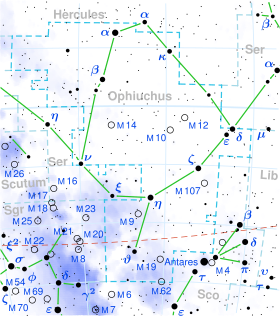astro.wikisort.org - Star
ξ Oph, Latinized as Xi Ophiuchi, is a visual binary star[9] system in the equatorial constellation of Ophiuchus.[2] It has a yellow-white hue and is faintly visible to the naked eye with a combined apparent visual magnitude of 4.39.[2] The system is located approximately 56.6 light years away from the Sun based on parallax,[1] but is drifting closer with a radial velocity of -9 km/s.[5]
| Observation data Epoch J2000 Equinox J2000 | |
|---|---|
| Constellation | Ophiuchus |
| Right ascension | 17h 21m 00.37520s[1] |
| Declination | −21° 06′ 46.5663″[1] |
| Apparent magnitude (V) | 4.39[2] |
| Characteristics | |
| Spectral type | F2V[3] |
| U−B color index | -0.06[4] |
| B−V color index | +0.41[4] |
| Astrometry | |
| Radial velocity (Rv) | −8.93±0.30[5] km/s |
| Proper motion (μ) | RA: +263.84[1] mas/yr Dec.: -205.85[1] mas/yr |
| Parallax (π) | 57.62 ± 0.26 mas[1] |
| Distance | 56.6 ± 0.3 ly (17.36 ± 0.08 pc) |
| Absolute magnitude (MV) | 3.19[2] |
| Details[6] | |
| A | |
| Mass | 1.30 M☉ |
| Radius | 1.59±0.06 R☉ |
| Luminosity | 4.429±0.035[5] L☉ |
| Surface gravity (log g) | 4.15±0.10 cgs |
| Temperature | 6,611±80 K |
| Metallicity [Fe/H] | −0.27±0.07 dex |
| Rotational velocity (v sin i) | 20.2±0.7 km/s |
| Age | 916[7] Myr |
| Other designations | |
| Database references | |
| SIMBAD | data |
The magnitude 4.40[10] primary, designated component A, is an ordinary F-type main-sequence star with a stellar classification of F2V.[3] It is 916[7] million years old and is rotating with a projected rotational velocity of 20 km/s. The star has 1.3 times the mass of the Sun and 1.6 times the Sun's radius.[6] It is radiating 4.4[5] times the luminosity of the Sun from its photosphere at an effective temperature of 6,611 K.[6]
The system is a source of X-ray emission.[11] The orbiting companion, component B, is a magnitude 8.9 star at an angular separation of 35″ along a position angle of 27° from the primary, as of 2015. A magnitude 10.8 visual companion, component C, lies at a separation of 10.8″, as of 2004.[10]
References
- Van Leeuwen, F. (2007). "Validation of the new Hipparcos reduction". Astronomy and Astrophysics. 474 (2): 653–664. arXiv:0708.1752. Bibcode:2007A&A...474..653V. doi:10.1051/0004-6361:20078357. S2CID 18759600. Vizier catalog entry
- Anderson, E.; Francis, Ch. (2012). "XHIP: An extended hipparcos compilation". Astronomy Letters. 38 (5): 331. arXiv:1108.4971. Bibcode:2012AstL...38..331A. doi:10.1134/S1063773712050015. S2CID 119257644. Vizier catalog entry
- Gray, R. O.; Corbally, C. J.; Garrison, R. F.; McFadden, M. T.; Bubar, E. J.; McGahee, C. E.; O'Donoghue, A. A.; Knox, E. R. (2006). "Contributions to the Nearby Stars (NStars) Project: Spectroscopy of Stars Earlier than M0 within 40 pc--The Southern Sample". The Astronomical Journal. 132 (1): 161–170. arXiv:astro-ph/0603770. Bibcode:2006AJ....132..161G. doi:10.1086/504637. S2CID 119476992.
- Mallama, A. (2014). "Sloan Magnitudes for the Brightest Stars". The Journal of the American Association of Variable Star Observers. 42 (2): 443. Bibcode:2014JAVSO..42..443M.Vizier catalog entry
- Brown, A. G. A.; et al. (Gaia collaboration) (August 2018). "Gaia Data Release 2: Summary of the contents and survey properties". Astronomy & Astrophysics. 616. A1. arXiv:1804.09365. Bibcode:2018A&A...616A...1G. doi:10.1051/0004-6361/201833051. Gaia DR2 record for this source at VizieR.
- Fuhrmann, K.; Chini, R.; Kaderhandt, L.; Chen, Z. (2017). "Multiplicity among Solar-type Stars". The Astrophysical Journal. 836 (1): 139. Bibcode:2017ApJ...836..139F. doi:10.3847/1538-4357/836/1/139.
- David, Trevor J.; Hillenbrand, Lynne A. (2015). "The Ages of Early-Type Stars: Strömgren Photometric Methods Calibrated, Validated, Tested, and Applied to Hosts and Prospective Hosts of Directly Imaged Exoplanets". The Astrophysical Journal. 804 (2): 146. arXiv:1501.03154. Bibcode:2015ApJ...804..146D. doi:10.1088/0004-637X/804/2/146. S2CID 33401607. Vizier catalog entry
- "ksi Oph". SIMBAD. Centre de données astronomiques de Strasbourg. Retrieved 2019-10-08.
- Eggleton, P. P.; Tokovinin, A. A. (September 2008). "A catalogue of multiplicity among bright stellar systems". Monthly Notices of the Royal Astronomical Society. 389 (2): 869–879. arXiv:0806.2878. Bibcode:2008MNRAS.389..869E. doi:10.1111/j.1365-2966.2008.13596.x. S2CID 14878976.
- Mason, Brian D.; et al. (200). "The 2001 US Naval Observatory Double Star CD-ROM. I. The Washington Double Star Catalog". The Astronomical Journal. 122 (6): 3466. Bibcode:2001AJ....122.3466M. doi:10.1086/323920. Vizier catalog entry
- Haakonsen, Christian Bernt; Rutledge, Robert E. (September 2009). "XID II: Statistical Cross-Association of ROSAT Bright Source Catalog X-ray Sources with 2MASS Point Source Catalog Near-Infrared Sources". The Astrophysical Journal Supplement. 184 (1): 138–151. arXiv:0910.3229. Bibcode:2009ApJS..184..138H. doi:10.1088/0067-0049/184/1/138. S2CID 119267456.
На других языках
- [en] Xi Ophiuchi
[ru] Кси Змееносца
Кси Змееносца; ξ Змееносца (Xi Ophiuchi, ξ Ophiuchi, сокращ. Xi Oph, ξ Oph) — кратная звёздная система в экваториальном созвездии Змееносца. Звезда имеет видимую звёздную величину +4.39m[2], и, согласно шкале Бортля, видна невооружённым глазом даже на городском небе (англ. City sky). Из измерений параллакса, полученных во время миссии Hipparcos[1], известно, что звезда удалена примерно на 56,6 св. лет (17,36 пк) от Земли. Звезда наблюдается южнее 69° с. ш., то есть видна практически на всей территории обитаемой Земли, за исключением северных полярных областей. Лучшее время для наблюдения — июнь[19].Другой контент может иметь иную лицензию. Перед использованием материалов сайта WikiSort.org внимательно изучите правила лицензирования конкретных элементов наполнения сайта.
WikiSort.org - проект по пересортировке и дополнению контента Википедии
